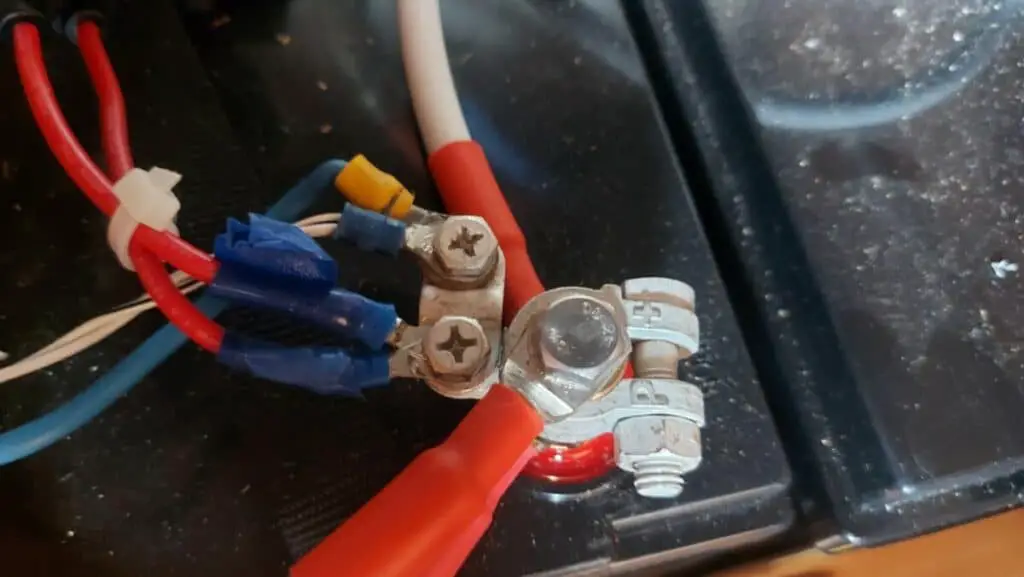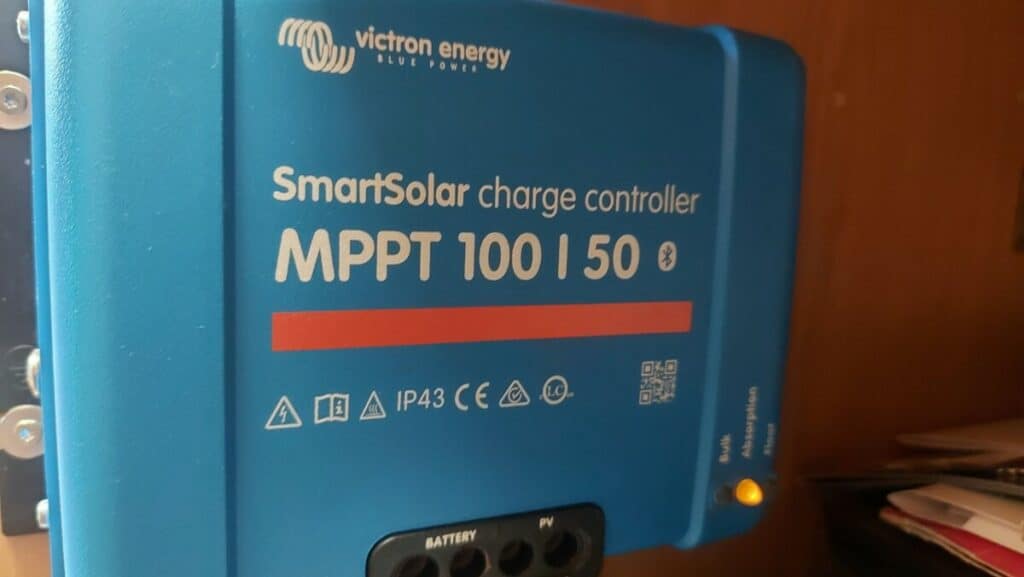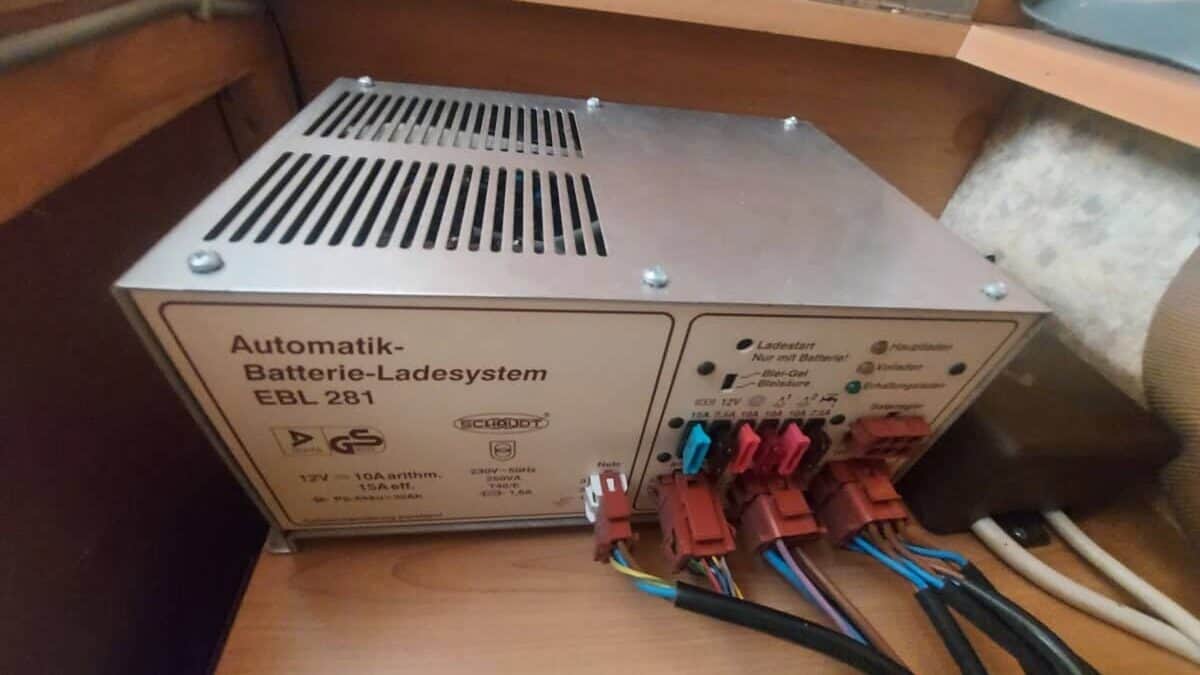This post contains affiliate links (I get a commission at no extra cost to you for purchases made through links in this post).

There are many options and requirements to get your motorhome, caravan, or RV fridge to run on the battery. Due to high energy consumption, it is just not a good idea in some cases, but connecting it is easy.
To run your Motorhome fridge on battery, locate the 12v wires from the refrigerator and connect them to the battery. Connect a fuse to the positive wire if there is none. If your fridge can’t run on 12 volts but instead of 220 or 120 volts, you need to connect it to your battery via an inverter.
There are different ways of running your fridge on the battery. Still, to do so, you need to be aware of the total energy consumption of your fridge and the capacity your batteries have to know if it will work for you. Also, there is usually a reason why your fridge is not already connected directly to the 12-volt battery, so dont plug it in without some research or reading this whole article where I simplify the information you need below if you don’t want to risk draining your batteries within hours.
“There is usually a reason why your fridge is not already connected directly to the 12-volt battery”
For those who have already done the research and know that you can run your fridge on batteries, it is time to plug it in. If unsure, you can scroll down to “How long can you run a Motorhome or RV fridge on a 12V battery?”
Does a 12V Fridge Need an Inverter?

If you have a 12 volts fridge, you do not need an inverter to run it from a 12-volt battery. The refrigerator comes with a 12-volt power cable that you connect directly to the battery or existing 12-volt outlet. However, if the fridge is not made for 12 volts but instead 220 or 120 volts, you will need an inverter.
The inverter, converter, power transformer, or however you call it, is a device connected to your battery bank and converts the 12-volt power into a higher voltage like 220 volts. You will need an inverter to run appliances with a higher voltage.
You will need an inverter if you have a typical household or dorm fridge that can only be connected to 220 volts – a standard power outlet inside your house. However, you will not need an inverter if you have a refrigerator that you can run from the 12-volt outlet in your car, like a smaller camping fridge or a specially made motorhome or RV fridge.
How To Connect Fridge via Inverter

If you have an inverter installed in your motorhome or RV and want to connect your fridge to it, plug in the fridge’s power cord to the outlet on the inverter and keep the inverter turned on the whole time you want the refrigerator to be running.
The inverter will typically have a fan that turns on from time to time to keep the inverter cool which could be a bit noisy.
If you do not have an inverter installed already, you can install one yourself if you have done some wiring before or read about it for a couple of hours. Make sure to get an inverter with cables and fuses, so you don’t have to worry about getting those in the correct size since this requires more research and information. Follow the installation guide for your inverter, and you will do great.
Make sure you get an inverter that will cover your needs; maybe you want to run other appliances on it as well, be sure to control the wattage of all the devices you want to be running simultaneously and get an inverter that is powerful enough for those. Also, ensure you get the correct type of inverter; pure sine wave inverters are more expensive than modified sine wave inverters. Still, unfortunately, the more expensive option is what we want when running appliances such as a fridge, microwave, or sensible equipment.
How to Connect 12v Fridge to 12v Battery


A 12v camping-style fridge or cooling box typically comes with a 12-volt connection that you can plug into a standard 12v outlet (cigarette lighter). This is an excellent option if you want to be able to move your cooling box or fridge quickly; maybe you want to use it in your regular car as well as in the motorhome. Then this option gives you more flexibility.
Be aware that you dont connect it to an outlet linked to your starter battery when the engine is not running. Otherwise, you risk draining the battery and might be unable to start the engine when needed. So be sure you have a 12v outlet connected to your “house battery,” or install one if you want to run the fridge while the engine is not on.
“Be aware that you dont connect it to an outlet linked to your starter battery when the engine is not running.“

If you want to install it more permanently, connect it directly to the battery to avoid the plug falling out or being in the way. Cut off the 12 v plug/connection to get the ends of the power cable to work with and install it as you would a designated motorhome fridge.
A designated Motorhome or RV fridge probably won’t come with a 12v plug to connect to a cigarette outlet. Instead, connecting it directly to your fusebox or battery is more common since it will be more permanently installed.
Step 1. Pull the 12v cables to the battery.
Locate your 12v wires and pull them nicely to your battery bank. You want the cables to lie protected, so they won’t break or be in the way of your other things, try to locate other wires nearby that also go to the battery and run the cables together. Put your fridge in place and give the wires a bit of slack so you can move the refrigerator later if needed.
Step 2. Connect a fuse holder.
Connect a fuse holder to your positive wire near the battery at a suitable and easy-to-get-to location. Choose a fuse by taking the total wattage of the fridge and dividing it by 12, round it up, and that’s the number of amps your fuse should have. For example, a refrigerator with 125 watts. 125 / 12 = 10.4 – I have ten amps or 15 amp fuses, so I will choose a 15 amp fuse since a 10 amp fuse would be blown as soon as you turn on the fridge.

Step 3. Connect the positive and the negative cable to the battery.
Do not put in the fuse yet; instead, connect the other end of the fuse holder to your battery. Now your positive wire is connected to the battery, then connect your negative wire to the battery, put in the fuse, and your fridge is connected directly to your battery and ready to be used.


Step 4. Put in the fuse and start the fridge, done.
Now for those who are not sure if you will be able to run a fridge on your battery, it is time to check some numbers. Let’s dive into the different energy consumption motorhome fridges have, how much your solar panels recharge your battery, and how much your battery gets recharged while driving.
How Long Can You Run a Motorhome or RV Fridge on a 12V Battery?

I have made a table to show how long you can run the most common motorhome (RV) fridges on 100AH Lithium or AGM/GEL batteries and how much energy they consume each hour and day, but first, a short introduction to the different types of fridges I compare.
Absorption fridges are the ones that can run on gas/propane, and they are very inefficient on electricity.
A mini household/dorm fridge is a “normal” smaller compressor fridge that runs on 220v or 120v.
12v Compressor fridges are much more efficient than absorption and thermoelectric but can look similar.
12v Thermoelectric cooler is a normal cheap coolbox; it runs all the time and does not cool efficiently.
| Type of fridge | Consumption Ampere/hour | Consumption Ampere/day | Battery Runtime 100AH *(80AH) Lithium | Battery Runtime 100AH (*50AH) GEL/AGM |
| Absorption fridge 125 Watts | 10.4 AH | 250 A / day | 7,7 hours | 4,8 hours |
| Absorption fridge 110 Watts | 9,1 AH | 220 A / day | 8,8 hours | 5,5 hours |
| 12v Compressor fridge 60W 0.3 KWh / 24 hours | 1,04 AH | 25 A / day | 77h (3,2 days) | 48h (2 days) |
| 12 v Compressor fridge 45W 0.2KWh/ 24 hours | 0,69 AH | 16,6 A / day | 116h (4,8 days) | 72h (3 days) |
| *Mini Household/dorm fridge 75KWh/Anum (0,2KWh/ 24 H) | 0,69 AH | 16,6 A / day | 116h (4,8 days) | 72h (3 days) |
| *Mini Household/dorm fridge 125KWh/Anum (0,34KWh/ 24H) | 1,18 AH | 28,3 A / day | 68h (2,8 days) | 42h (1,7 days) |
| 12v Thermoelectric cooler 45W | 3,75 AH | 90 A / day | 21 hours | 13 hours |
| 12v Thermoelectric cooler 65W | 5,41 AH | 130 A / day | 15 hours | 9 hours |
* Im counting with the most common depth of discharge (DOD) of 80% in the lithium battery; basically that the battery only has 80AH of usable energy. And a DOD of 50% in the gel/AGM battery. The depth of discharge or usable energy may differ between 50-70% on gel/AGM batteries and 80-100% on lithium batteries.
* Mini household/dorm fridge would need to be run via an inverter that converts the 12-volt power from the battery up to 110 or 220 volts to run those refrigerators. These inverters consume a bit of energy just by being turned on all the time. 0,5-2 AH just in idle mode, and then you can add 5-20% of the consumption due to inefficiency
As you can see, the difference is enormous, and that absorption fridge uses a tremendous amount of energy when they run on your battery bank. Therefore, it is generally not a good idea to run your absorption fridge from 12v batteries. On the other hand, with a compressor fridge, it makes sense to use your battery, especially if you have solar panels or drive to recharge your batteries.
Absorption fridges use a tremendous amount of energy, unless you have a massive batterybank or run a generator constantly it does not make sense.
How Much Do my Motorhome (RV) Solar Panels Charge my Battery?


So you want to run your fridge on solar and wonder how much this recharges your batteries daily. Take a look at the table below for answers.
| Amount of watts on solar panels. | sunny area* recharge capacity / day | average area* recharge capacity / day | cloudy area* recharge capacity / day |
| 100 watts solar panels | 50 AH | 33 AH | 20 AH |
| 200 watts solar panels | 100 AH | 66 AH | 41 AH |
| 300 watts solar panels | 150 AH | 100 AH | 62 AH |
| 400 watts solar panels | 200 AH | 133 AH | 83 AH |
| 700 watts solar panels | 350 AH | 233 AH | 145 AH |
* The sunny area in this example is California or any area that averages six peak sun hours per day.
* The average area in this example is New jersey or any area that averages four peak sun hours per day.
* The cloudy area in this example is Alaska or any area that averages 2,5 peak sun hours per day.
These are the average numbers of how much your solar panels will charge during the year in different zones. So, for example, if you have an absorption fridge of 125 watts that consumes 250 Amps per day with 700 watts of solar panels in new jersey or any other place with an average of four peak sun hours per day, it would not be enough! But you would be OK with a compressor fridge and 100 watts of solar in the same place.
Remember that you want some redundancy when it will be cloudy for a week or if you want to use the battery to run something else. Remember that these are average numbers and that you must plan your electrical system for cloudy days.
How Much Does my Generator Charge my Motorhome Battery While Driving?

Here you have a table to show the most common types of dc/dc chargers with a capacity of 10 to 30 amps and how much they charge your battery while driving for 1, 3, 5, or 7 hours.
| The capacity of Dc/Dc battery charger | AH charged while driving 1 hour | AH charged while driving 3 hours | AH charged while driving 5 hours | AH charged while driving 7 hours |
| 10 amp | 10AH | 30AH | 50AH | 70AH |
| 15 amp | 15AH | 45AH | 75AH | 105AH |
| 20 amp | 20AH | 60AH | 100AH | 140AH |
| 25 amp | 25AH | 75AH | 125AH | 175AH |
| 30 amp | 30AH | 90AH | 150AH | 210AH |
Let’s take an example from our tables here. Let’s say you want to run an absorption fridge of 125 watts on your battery that consumes 250 amps/day. You drive your motorhome or RV for 5 hours per day with a 20 amp dc/dc battery charger, so you will get an extra 100AH recharged to your battery each day; this won’t be enough to run this type of fridge. On the other hand, with a compressor fridge that consumes 25 Amps/day, you have plenty of energy, and it will be a good idea to connect it to your 12-volt battery.
